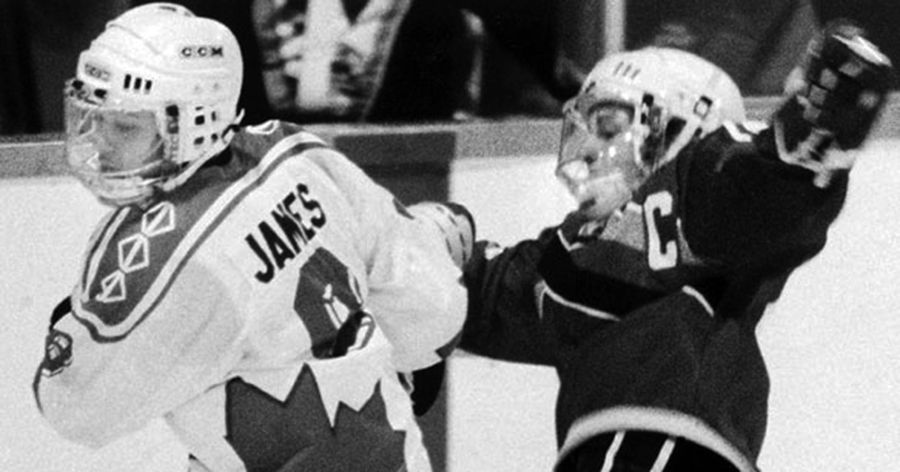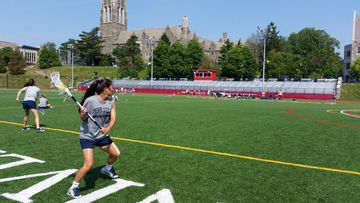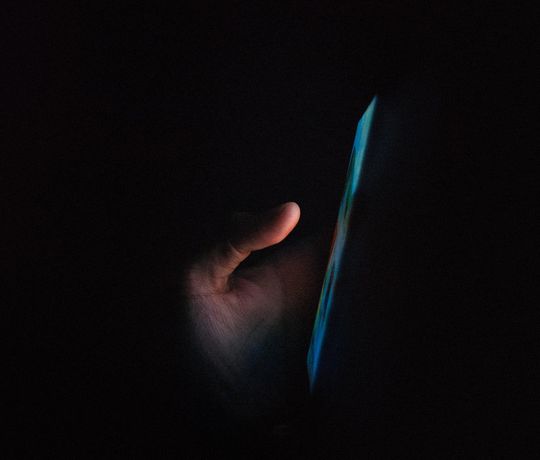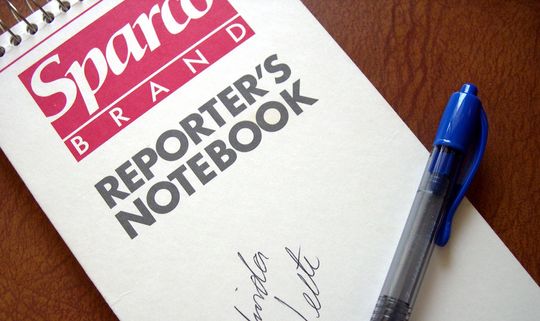There are women from my childhood who remain important today. Women I've never met. Women who I only saw playing sports, usually on TV. There were many of these women in the 1990s: women who proved that they could compete, excel, and win; but Angela James was always one of the most important women to me.
James meant something to me as a kid. I didn’t face the same difficulties she did as a child, nor did I experience the racism she dealt with as a woman of color playing ice hockey (which at the time was predominantly white), but she had a huge imapct on me. For starters, she played my favorite sport. She played center and defense, like me. She had short hair like me. She was a tomboy as a kid, and not stereotypically feminine, like me. She was seen as big and tough and so was I.
And she was a superstar.
In the brief glimpses I got of those early IIHF Women’s World Championships on TV, James was always a prominent figure. I sometimes daydreamed about winning the Stanley Cup, but I also imagined playing for Canada and winning gold -- because of players like James and the increased visibility that they got during my childhood.
I didn’t fit in as a kid. I was teased, bullied, and harassed at school, primarily because of my gender presentation. I didn’t fit in and therefore didn’t have value in the eyes of my peers...except in sports. While my gender presentation was occasionally a problem for the kids I played with, it was often an issue for their parents. But playing softball, soccer, basketball, and hockey led to acceptance and friendships. It also led to my height, my size, and my strength being seen as valuable, positive qualities, rather than just as things that othered me.
As a kid in the 1990s, women’s sports were important, integral, and essential to me. Because of the Olympics and the World Championships I saw people who looked like me excelling on an international stage...I saw them earn respect and adulation. Their struggles and successes created opportunities for me to play and leagues that would accept me. That might seem dramatic, but I played in the inaugural season of the first girls’ hockey league in my region when I was nine. In its earliest years, such a league still faced considerable opposition. That league existed for many reasons, among them the growing visibility of the women’s game and the efforts of those Canadian national team members and senior league players who fought not only to create spaces for themselves to play, but also to make room for the next generation of girls.
I saw James play when I was a kid. I went with a group of kids and parents from my minor hockey team. The trip had a “girl power” vibe to it, but when it came to James, those ideals were forgotten. When I was younger, I was always aware of what adults were doing and saying, and to them, James was selfish and brash and not a "team player." Her race was discussed and insulted. Eventually, one of the dads got to the crux of their dislike: she was “off.” When pressed by one of the moms, he said James slept with women, that she was a dyke and cunt. I remember what he said because it was the first time I had heard the terms cunt and dyke and understood what they meant, and understood that they were meant as insults to her character.
I remember when I found out that James didn’t make the roster for the Olympics in Nagano. I was stunned. She would have been 33 at those Olympics. It’s hard to describe to younger fans how shocking this was. A comparable example would be if Canadian head coach Melody Davidson cut Hayley Wickenheiser on the eve of the Vancouver Games in 2010. While James was no longer in her prime, she was still useful, and was the team’s leading scorer in the preliminary games leading up to the Olympic camp. Shannon Miller, the coach of Canada’s women’s team in Nagano, said James was cut because she wasn’t a “team player.”
However, James was willing to accept a smaller role and be a “team player” for the national team at the Three Nations Cup the following year. James never bought Miller’s reasoning and appealed the decision, unsuccessfully. The season after her Olympic snub, James proved she had more to give. She scored 38 goals and 55 points in 31 games for the Beatrice Aeros in the original NWHL’s inaugural season, winning the MVP award. Washed up indeed. Not a team player? Washed up, as some said? Hardly.
When you read about James, the Olympic snub is described as “controversial,” “questionable,” and “contentious.” And certainly, Miller’s decision has never been fully or adequately explained. What gets forgotten is how bigotry derailed James’ appeal and impacted viewers' perceptions. A rumor circulated that James, the team captain, was in a relationship with the coach. It caught the attention of the media and Hockey Canada, with the Olympic spotlight looming. James is blunt when she describes the ways in which discrimination directly impacted the proceedings: “Homophobia ruined my appeal.”
The season after her Olympic snub, James proved she had more to give. She scored 38 goals and 55 points in 31 games for the Beatrice Aeros in the original NWHL’s inaugural season, winning the MVP award. Washed up indeed. Not a team player? Washed up, as some said? Hardly.
Gay female athletes sometimes don’t come out publicly because of old and persistent stereotypes about women who play sports. When discussing why her appeal was denied, James acknowledged that “every female sport” is subjected to those stereotypes. James has been out since she was 15 years old and is the first openly gay player in the Hockey Hall of Fame. When considering her legacy, the homophobia she experienced is often buried, while the racism and sexism she also experienced is acknowledged. We talk about her as a legend of Canadian hockey, but we don’t critique the Canada that shaped the bigotry in the sport or the bigotry that so often targeted James. We don’t talk about the intersections of bigotry, harassment, and abuse.
James shows us that there is a very fine line in girls’ and women’s sports. Athletes and advocates often refer to sports like hockey as empowering for girls, but they are only empowering for some. Girls and women who are gender nonconforming, nonbinary, or trans are erased. Girls and women who are butch, masculine, or simply not feminine in the right ways are erased. Girls and women who aren’t straight are erased.
We are increasingly willing to celebrate the achievements of female athletes -- and we should. What we aren’t willing to do is be honest about the real issues of diversity in women’s sports. As women’s sports get more mainstream attention, the players and competitions become more palatable to mainstream audiences. That palatability is defined by being shown to promote cis, straight, and conventionally attractive players over others who don't fit neatly into these categories.
Like many, I followed the inaugural season of the new NWHL in 2015-16 with excitement. Another professional hockey league for women to play in is a good thing. A league willing to pay players is a good thing. More opportunities for women to play professionally in the United States is a good thing. But the inaugural season was also disappointing. Not because of the struggles the NWHL dealt with; many new organizations struggle with funding and personnel turnover. What disappointed me was the continued promotion of female hockey players within cishet-normative paradigms.
Why are we still pretending that women’s hockey is wholly straight and cis?
LGBTQIA athletes aren’t a new phenomenon; they have always been a part of sport. It matters when players come out when they’re still playing. It still matters when they come out long after their playing days are over.
We know that women of varying sexualities have played and currently play the game. We know that female hockey players have presented themselves in a variety of ways. And yet women’s hockey has increasingly become more publicly heteronormative, despite the number of women who are out to their teammates.
I don't require that athletes must always be role models, though my childhood experiences certainly illustrate how valuable they can be in that role. But as part of legitimizing and growing the game, female players are conscious of the influence they have on kids. We expect a lot more of our female athletes than our male athletes in this respect, but what kind of roles are being modeled?
Supporting women’s sports and female athletes—all female athletes—is still a transgressive act. It disrupts patriarchal assumptions and priorities.
I think back to those parents who hated James because she was a woman of color and because she was out, and those who hated her because of the combination of those things. I recall the role homophobia played in her missing out on the 1998 Olympics. I remember how that homophobia and her sexuality have been erased from the most controversial aspect of her legacy.
I think back and I find possible answers.
Girls and women playing sports is only palatable to mainstream (white, straight, cis, male) audiences when it reinforces traditional standards of white feminine beauty and normative sexuality. Supporting women’s sports and female athletes -- all female athletes -- is still a transgressive act. It disrupts patriarchal assumptions and priorities. But women who are queer and are athletes are seen as suspect, who are subject to greater scrutiny. Women who excel athletically but are not conventionally feminine have their gender undermined and questioned. When we think of female athletes as role models, many prefer role models who will ensure that the cis, straight, conventional norm is perpetuated in younger generations. Society doesn’t think of queer kids and what they need, and what sports has to offer them. Promoting only a certain type of womanhood may make women’s hockey more palatable to a larger group of people, but this palatibility comes at a considerable cost.
When female athletes do come out publicly, they are often othered by both fans and the mainstream media. Charlene Labonté, a CWHL and Canadian national team veteran, came out after the Olympics in 2014. She stated:
“I'm a four-time Olympian. I am the daughter of wonderful parents and the sister of a very special brother. I am friends with people who fascinate me, support me, and without whom I could not live out my dreams. I am a student and I will earn my masters from McGill University this fall. I am gay and proudly authentic.”
Labonté articulated both her pride in her sexuality and a full and varied identity. Yet hockey media reduced her words to “inspiration” for an assumed straight readership. Worse, her coming out was portrayed as a victory validating the hard and tireless work of straight allies, instead of that of queer athletes who have risked careers and of those fans who have pushed for equality at all levels of sport for years.
This isn’t unique to women’s hockey; it happens in other women’s sports. Even the most famous gay female athletes deal with a public who is both unable and unwilling to acknowledge their lives and relationships as natural and normal. Much attention was paid and much was written about the sheer volume of publicly out players at the 2015 Women’s World Cup. More than a dozen players and two coaches had publicly identified as lesbian, bisexual, or as having other sexualities -- not as straight. The USWNT, the eventual winner of the tournament, were celebrated not just for their play, but for being led by out coach Jill Ellis and gay stars Abby Wambach and Megan Rapinoe, as well as out defender Ali Krieger. But when Wambach celebrated winning the World Cup, by racing to the sidelines to be with her loved ones like so many athletes before her, her actions were misinterpreted.
Wambach kissed her wife, Sarah Huffman.
A week and a half after the U.S. Supreme Court legalized gay marriage across the nation, networks were commended for staying with the footage. Yet, Getty Images, a prominent stock photography company, initially captioned the moment of Wambach and Huffman’s kiss as Wambach “celebrates with a friend.” The caption was criticized and subsequently changed, but earlier in the tournament, Getty Images had done the same thing to Canadian goalkeeper Erin McLeod, who came out publicly in the wake of anti-LGBTQIA legislation in Russia before the Sochi games. Getty had no trouble recognizing players who were celebrating with their male partners but queer sexuality was other, different, and unfamiliar. It wasn’t recognized as love.
Many of us think that we’ll collectively rise to the occasion when presented with a publicly out queer player. But stars like Wambach, who had their sexuality scrutinized and their love erased, should force us to realize how consistently we fail LGBTQIA athletes. Passive acknowledgements are not enough, and often come far too late.
We often hear from ally organizations that “hockey is waiting for its first gay player.” Scanning the ranks of women’s hockey for players who were publicly out during their careers or came out publicly after retirement reveals what the hockey world prioritizes: a white, cis, male, gay player. That player is prioritized because he will be used as an example of hockey’s tolerance and will be seen as a reflection of the growth that straight people are capable of experiencing. We don’t recognize what we already have: women coming out publicly, despite the fact that to do so defies how women’s hockey and women’s hockey organizations promote the game as straight, cis, normative, and above all, socially “safe.” We don’t acknowledge these women because what the hockey world wants is one shining gay example, one player to illustrate our tolerance. We don’t want a few dozen queer women. We don’t want to be challenged that often, we don’t want to adapt, we don’t want to change. Consequently, we are failing LGBTQIA female athletes.
Scanning the ranks of women’s hockey for players who were publicly out during their careers or came out publicly after retirement reveals what the hockey world prioritizes: a white, cis, male, gay player. That player is prioritized because he will be used as an example of hockey’s tolerance and will be seen as a reflection of the growth that straight people are capable of experiencing.
Women’s sports have always been a part of my life, but I've begun to feel increasingly distant from them. They were important because my gender nonconformity was accepted when I played and reflected in the athletes I watched. Since coming out as trans, I’ve increasingly felt distanced from women’s hockey because of the cishet-normativity toward which women’s hockey has leaned.
Women’s hockey doesn’t need to include me. Men’s sports certainly aren’t trying and don’t try to be inclusive of LGBTQIA folks, and there’s not much out there that’s inclusive of trans people and finds us worthy of full participation. But in a sport that values its role models, a sport that is concerned with girls who are growing up playing the game now, women’s hockey is actively projecting a worrying normativity. Kids who don’t conform, in gender or sexuality or presentation, need role models too. These role models are around, but the sport often chooses to place them in secondary roles, or exclude them altogether. Queer and trans kids deserve better.
LGBTQIA folks don’t owe straight and cis people their stories and they aren’t required to reveal their pain or private experience. They don’t need to come out publicly for the sake of it and they aren’t required to do so for the betterment of others. But what we need to stop doing as sports fans is foolishly pretending women’s sports is the exclusive domain of cisgendered straight women. We need to celebrate all athletes, regardless of their gender, sexuality, and presentation. The result when we ignore and erase those who exist outside the norms, those who are queer, is damaging. It perpetuates the mistakes that have been made (and are still being made) in men’s sports. Far from being conventional, normal, or safe, it’s actually quite harmful.
The diversity in women’s sports is being gradually sacrificed in an attempt to become mainstream. Those who are left behind still remain unseen by a rapidly growing audience.







